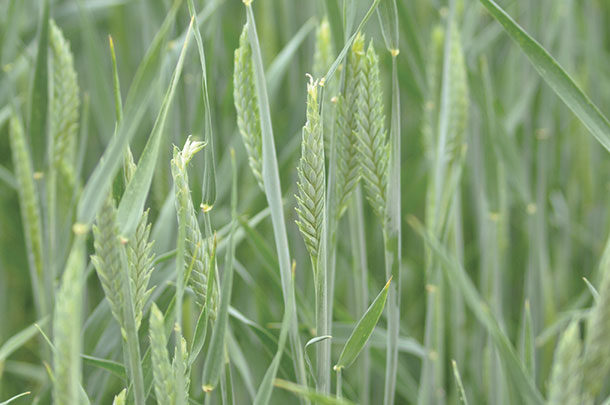Winter cereal grains have branched far from their traditional grain and straw end uses, especially in recent years. They’re now thought of as everything from emergency forage, intentional double-cropped forage, soil-building cover crop for a quick injection of organic matter and a break crop.
Small grains are cheap to plant, easy to manage and – even when intended as a forage – help with the “classic” cover crop functions of uptaking excess nutrients and keeping soil covered to keep erosion and weeds in check.
Small grains, and rye in particular, have become famous for their allelopathic effects – the secretion of chemicals that inhibit weed seed germination. They also grow quickly in the fall and make a solid backbone for a cool-season annual mix with legumes (peas, vetch or crimson clover) and brassicas.
Triticale, wheat, barley and rye vary in winter hardiness but are generally strong winter survivors, which means they are handy for providing an insulating effect for less hardy species such as crimson clover. (Oats do not survive the winter in northern regions but, even when winter-killed, can provide some insulation to species growing beneath their canopy.)
In the event of a poor stand or low population, small grains also have the ability to fill out through tillering (growing more stems per plant). Over-wintering small-grain forages also buffer soil in the fall to moderate temperature extremes – bare soil fluctuates much more in temperature and is also an inhospitable habitat for soil microbes.
What to do now to get the best forage
Following proper planting procedures is the best way to ensure a robust stand. If you planted small grains, they are likely in the ground by now, although rye and triticale may be planted a little later in southern Pennsylvania and further south.
With small grains used for forage, it’s generally advisable to get them planted three to four weeks earlier than the same species planted for grain production.
Hitting the right planting depth (1 to 2 inches) helps the seedlings establish solid root structures, which will benefit their growth throughout their life cycles as well as prevent frost-heaving.
Using a seeding rate to match your timing is also important: The later you plant, the less time there is for tillering.
Proper fertility with the right timing is also key. It helps to give the seedlings a head start with some nitrogen at planting in addition to lime, phosphorus and potassium (according to soil tests).
We recommend splitting nitrogen application between fall and spring to minimize losses, keep consistency over the growth cycle and prevent nitrate toxicity.
It is best to keep as much distance between fertilizing and grazing or harvest as possible, since nitrate poisoning usually occurs when the plant is growing rapidly and accumulating the nitrates from recent fertilization in its tissues. Most of the fertility can be applied at spring green-up (a 30 percent/70 percent split is typical).
Fall grazing
For over-wintering species, a late fall or early spring grazing can be done if conditions are right, starting when plants are about 6 to 8 inches tall. One thing to keep in mind is: The tissue will be high in protein, which can actually prevent animals from gaining weight if not slowed down with effective fiber.
Don’t overgraze; leave about 3 to 4 inches residual to be sure the plants have plenty of root reserves and energy to survive the winter. In northern growing zones, a fall grazing may not be possible – it all depends on how early the crop can be established and grow a good 6 to 8 inches of growth.
If you planted early with a fall grazing in mind, make sure the crop is tall enough, is well established and is tillering before grazing. You want to allow enough time for the crowns to develop, with three to five tillers per plant before going into winter.
Even in the absence of a planned fall grazing, seeding timing sets up plants for winter hardiness or lack thereof and depends on growing zone and average first frost date.
Planting too early could mean excess fall growth that would leave the plant tissue vulnerable to freeze damage or snow mold from too much matting, while getting it in too late doesn’t give the plant time to establish a tough root system and energy stores to withstand single digits and below.
A more developed root system also helps protect the plant against heaving out of the ground with freezing and thawing. With later-than-recommended dates especially, make sure to increase seeding rates to compensate for the reduced window of time for tillering.
We also don’t want to wait too long in the fall and graze the plant at a later maturity (i.e., past jointing), as this can deplete energy reserves and harm its chances of winter survival.
Oats are a different story – they were likely planned as a fall forage only. Oats are a somewhat unique cool-season crop in the sheer yield they can produce in six to eight weeks, and the management plan will more than likely include only one grazing or cutting in late fall at boot stage to soft dough (depending on the forage quality needed).
True forage oats were developed to be a little later-maturing than grain oats, so they are generally not the types used to capitalize on the waning heat, cool nights and damper conditions of fall. Earlier-maturity oats tend to yield better in fall, while forage oats with delayed heading do best in the longer, hotter days of late spring that normally trigger heading.
Looking to spring
If it’s a rough winter with challenges like ice crusting or matting (leading to snow mold underneath), or just long periods of extreme cold with no snow cover, be sure to evaluate the stand around green-up time.
Guidelines from Penn State say seven to nine plants per foot of row produces an acceptable yield, and plants will often fill in what may look like considerable gaps with tillering. If the stand is poor, you may be able to salvage it with a no-till seeding of oats or other early spring- seeded crop – depending on timing, weed pressure and soil conditions.
Early spring growth in particular will be rapid and, for this reason, likely to be somewhat mineral-deficient. Grass tetany could be a concern, depending how many other types of feeds are incorporated into the diet, so a mineral supplement including magnesium is recommended.
Nitrogen application is a balancing act. Early spring green-up is the ideal time to apply the bulk of it – the warmer the soil and air temperatures, the more rapidly the plant will be growing and can uptake it, but it will also volatilize more easily.
It should also be applied early enough the plant has time to uptake and assimilate it so nitrate poisoning (especially for a spring grazing) does not become a concern.
Start grazing once plants are 6 to 8 inches tall, and be careful to manage closely. Move animals quickly with back-fencing, and do not overgraze if you plan to harvest later for forage or grain. You’ll want to graze only about half the height. To preserve a good stand, the pasture will likely have to be flash-grazed, with cattle moved several times a day.
Harvest at flag leaf to boot stage to maximize quality and yield for both lactating and finishing rations. Harvesting at soft dough stage can be done if a corn silage replacement or stretcher is needed, but the quality will be much lower. Wide-swath your harvest for the most rapid drying and lowest losses from respiration, and pack aggressively.
Even used as a planned forage, small grains benefit the rotation as a whole and can provide a variety of soil health and weed suppression benefits. ![]()
PHOTO 1: The hotter days of late spring normally trigger heading of triticale and other small grains. Photo by Genevieve Slocum.

-
Genevieve Slocum
- King’s AgriSeeds
- Email Genevieve Slocum










